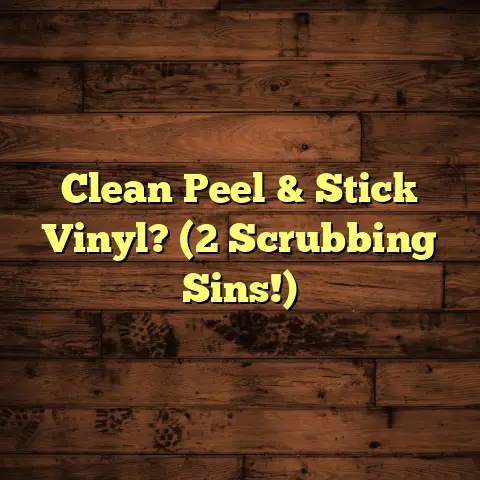What Is An Acid Wash For Tile?
Tile isn’t just a functional element; it’s a statement. Bold designs, whether through vibrant colors, intricate patterns, or unique textures, can completely transform a space. Think of a Mediterranean-inspired kitchen backsplash, a bathroom floor with geometric patterns, or a living room with large-format tiles mimicking natural stone. These designs add personality and character, but they also require proper care to maintain their beauty.
One of the most effective methods for rejuvenating tired or stained tiles is acid washing. It’s a technique that can breathe new life into your bold designs, restoring their original luster. But what exactly is acid washing? What are the benefits, and how does it work?
Let’s explore the world of acid washing and discover how it can help you preserve the stunning tile designs in your home.
Section 1: Understanding Acid Washing
So, what is acid washing, anyway? Simply put, it’s a deep cleaning process that uses an acidic solution to remove stubborn stains, grime, and mineral deposits from tile surfaces. It’s not your everyday mopping; it’s a more intensive treatment designed to tackle the tough stuff.
The acids commonly used in acid washing are typically hydrochloric acid (also known as muriatic acid) or phosphoric acid. These acids are diluted with water to create a solution that’s strong enough to dissolve mineral buildup, efflorescence (that white, powdery substance you sometimes see on tile), and other stubborn residues.
How does it work? Well, the acid reacts chemically with the stains and deposits, breaking them down so they can be easily rinsed away. Imagine it like this: the acid is like a tiny army of demolition workers, breaking down the unwanted elements on your tile’s surface.
Now, you might be wondering, “Isn’t regular cleaning enough?” Sometimes, yes. But acid washing goes beyond what typical cleaners can achieve. While ordinary cleaners remove surface dirt and grime, acid washing penetrates deeper to eliminate embedded stains and mineral deposits that ordinary cleaners can’t touch.
Think of it like this: regular cleaning is like shampooing your hair, while acid washing is like getting a deep-conditioning treatment at a salon. Both are important, but they serve different purposes. Acid washing is particularly suitable for tiles that have been exposed to hard water, alkaline cleaners, or grout haze left over from installation.
Section 2: The Science Behind Acid Washing
Alright, let’s get a little nerdy and talk about the science behind acid washing. I promise I’ll keep it as straightforward as possible!
The key to understanding acid washing lies in the chemical reactions that occur when the acidic solution comes into contact with the tile surface. Acids have a low pH level, which means they are highly reactive with alkaline substances. Most stains, mineral deposits, and grout haze are alkaline in nature, making them vulnerable to acidic solutions.
When the acid solution is applied to the tile, it reacts with these alkaline substances, breaking them down into smaller, more soluble compounds. This process is called neutralization. The acid essentially “eats away” at the stains and deposits, making them easier to remove with water and scrubbing.
For example, let’s consider calcium carbonate, a common component of hard water stains. Hydrochloric acid reacts with calcium carbonate to form calcium chloride, water, and carbon dioxide. The calcium chloride is easily dissolved in water and rinsed away, leaving the tile surface clean.
CaCO3 (s) + 2HCl (aq) -> CaCl2 (aq) + H2O (l) + CO2 (g)
Calcium Carbonate + Hydrochloric Acid -> Calcium Chloride + Water + Carbon Dioxide
pH levels play a crucial role in this process. The pH scale ranges from 0 to 14, with 7 being neutral. Acids have a pH below 7, while bases (alkaline substances) have a pH above 7. The lower the pH, the stronger the acid.
The pH of the acid solution used for washing must be carefully controlled to avoid damaging the tile surface. Too strong of an acid can etch or discolor certain types of tile, while too weak of an acid may not effectively remove stains. That’s why it’s crucial to dilute the acid properly and test it on a small, inconspicuous area before applying it to the entire surface.
Now, let’s talk safety. Working with acids requires precautions to protect yourself and your property. Here are some essential safety measures:
-
Wear protective gear: Always wear gloves, eye protection (goggles or a face shield), and a respirator to prevent skin and respiratory irritation.
-
Ensure proper ventilation: Work in a well-ventilated area to avoid inhaling acid fumes. Open windows and doors, or use a fan to circulate air.
-
Dilute the acid properly: Follow the manufacturer’s instructions for diluting the acid with water. Never add water to acid; always add acid to water to prevent splashing.
-
Protect surrounding surfaces: Cover nearby surfaces, such as walls, cabinets, and fixtures, with plastic sheeting to protect them from acid splashes.
-
Rinse thoroughly: After acid washing, rinse the tile surface thoroughly with clean water to remove any residual acid.
-
Neutralize the surface: After rinsing, consider neutralizing the surface with an alkaline solution, such as baking soda and water, to ensure that all traces of acid are removed.
Section 3: Types of Tiles That Benefit from Acid Washing
Not all tiles are created equal, and not all tiles respond the same way to acid washing. Some tiles benefit greatly from this treatment, while others may be more susceptible to damage. Let’s take a look at different types of tiles and their compatibility with acid washing.
-
Ceramic Tiles: Ceramic tiles are generally durable and resistant to acid damage, making them a good candidate for acid washing. However, it’s essential to test the acid solution on a small, inconspicuous area first to ensure that it doesn’t discolor or etch the surface. Acid washing can effectively remove stains, mineral deposits, and grout haze from ceramic tiles, restoring their original luster.
-
Porcelain Tiles: Porcelain tiles are even more durable and less porous than ceramic tiles, making them highly resistant to acid damage. Acid washing is often used to clean porcelain tiles after installation to remove grout haze and other residues. It can also help to remove stubborn stains and mineral deposits that have accumulated over time.
-
Natural Stone Tiles: Natural stone tiles, such as granite, marble, limestone, and slate, require more caution when it comes to acid washing. Some natural stones, particularly marble and limestone, are highly sensitive to acid and can be easily etched or discolored. Acid washing should only be performed on natural stone tiles by experienced professionals who understand the specific properties of each type of stone.
For example, I once worked on a project where the homeowner had installed beautiful marble tiles in their bathroom. Over time, the tiles had become stained with hard water deposits and soap scum. I carefully tested an acid solution on a small, hidden area of the tile and found that it caused slight etching. Instead of proceeding with acid washing, I recommended using a pH-neutral cleaner specifically designed for marble.
On the other hand, I’ve also successfully acid washed granite tiles to remove stubborn stains and mineral deposits. Granite is a very hard and dense stone that is highly resistant to acid damage. However, it’s still essential to test the acid solution first and to rinse the tiles thoroughly after washing.
Here’s a table summarizing the compatibility of different tile types with acid washing:
| Tile Type | Compatibility with Acid Washing | Notes |
|---|---|---|
| Ceramic | Generally good | Test first, especially on glazed surfaces. |
| Porcelain | Excellent | Very durable and resistant. |
| Granite | Good | Test first; generally resistant due to its density. |
| Marble | Poor | Very sensitive to acid; can etch easily. Use pH-neutral cleaners instead. |
| Limestone | Poor | Similar to marble; avoid acid washing. |
| Slate | Variable | Some types of slate are more resistant than others. Test first. |
Section 4: The Acid Washing Process
Alright, let’s get down to the nitty-gritty and talk about the actual acid washing process. Here’s a step-by-step guide to help you through it:
Step 1: Preparation
-
Gather your materials: You’ll need acid (hydrochloric or phosphoric), water, two buckets, a scrub brush, a mop, protective gear (gloves, eye protection, respirator), plastic sheeting, and pH-neutral cleaner.
-
Protect the area: Cover surrounding surfaces with plastic sheeting to prevent acid splashes.
-
Ventilate the area: Open windows and doors to ensure proper ventilation.
-
Test a small area: Before washing the entire surface, test the acid solution on a small, inconspicuous area to ensure that it doesn’t damage the tile.
Step 2: Application
-
Dilute the acid: Follow the manufacturer’s instructions for diluting the acid with water. Typically, a ratio of 1 part acid to 10 parts water is used. Always add acid to water, not the other way around.
-
Apply the solution: Using a mop or a scrub brush, apply the acid solution to the tile surface. Work in small sections to prevent the acid from drying out.
-
Scrub the surface: Use a scrub brush to agitate the acid solution and loosen stains and deposits. Pay particular attention to grout lines, where dirt and grime tend to accumulate.
Step 3: Post-Wash Care
-
Rinse thoroughly: After scrubbing, rinse the tile surface thoroughly with clean water to remove any residual acid. Use a mop or a wet vacuum to remove the rinse water.
-
Neutralize the surface: To ensure that all traces of acid are removed, neutralize the surface with an alkaline solution, such as baking soda and water. Mix 1/2 cup of baking soda with 1 gallon of water and apply it to the tile surface. Let it sit for a few minutes, then rinse thoroughly with clean water.
-
Dry the surface: Use a clean towel or a squeegee to dry the tile surface.
Tools and Materials:
- Acids: Hydrochloric acid (muriatic acid) or phosphoric acid.
- Buckets: Two buckets, one for the acid solution and one for rinsing water.
- Scrub brushes: Stiff-bristled brushes for scrubbing the tile surface.
- Mops: For applying the acid solution and rinsing the tile.
- Protective gear: Gloves, eye protection (goggles or a face shield), and a respirator.
- Plastic sheeting: To protect surrounding surfaces.
- pH-neutral cleaner: For neutralizing the tile surface after acid washing.
Remember, testing a small area is crucial. I can’t stress this enough! I once rushed into an acid wash job without testing, and ended up slightly etching a client’s beautiful slate entryway. Luckily, I was able to buff it out, but it was a stressful experience that taught me a valuable lesson. Always test first!
Section 5: Benefits of Acid Washing for Bold Tile Designs
So, why go through all the trouble of acid washing, especially for bold tile designs? Well, the benefits are numerous, both aesthetically and functionally.
-
Restores Vibrancy: Acid washing can remove stains and mineral deposits that dull the appearance of tiles, restoring their original vibrancy and color. This is especially important for bold designs that rely on bright colors and intricate patterns.
-
Enhances Clarity: By removing grout haze and other residues, acid washing can enhance the clarity of tile designs, making them appear sharper and more defined. This can significantly improve the overall look of a room.
-
Prolongs Tile Life: Regular acid washing can help to prolong the life of tiles by preventing the buildup of damaging substances, such as mineral deposits and mold. This can save you money in the long run by reducing the need for costly repairs or replacements.
-
Maintains Hygiene: Acid washing can kill bacteria and fungi that may be lurking on the tile surface, helping to maintain a clean and healthy environment.
I recently worked with a homeowner who had installed a stunning mosaic tile backsplash in their kitchen. Over time, the grout had become stained and discolored, making the entire backsplash look dull and lifeless. I performed an acid wash on the backsplash, and the results were incredible. The colors of the tiles popped, the grout looked clean and bright, and the entire kitchen felt refreshed.
The homeowner was thrilled with the results. They said that the acid wash had made their kitchen look brand new and that they couldn’t believe how much of a difference it had made.
I’ve seen countless similar transformations over the years. Acid washing can truly revitalize bold tile designs and bring them back to their former glory.
Section 6: Common Misconceptions About Acid Washing
Despite its many benefits, acid washing is often shrouded in misconceptions. Let’s debunk some common myths and set the record straight.
-
Myth: Acid washing is dangerous and will damage my tiles.
Fact: When performed correctly, acid washing is a safe and effective method for cleaning tiles. However, it’s essential to use the right type of acid, dilute it properly, and test it on a small area first. Some tiles, such as marble and limestone, are more sensitive to acid and may require alternative cleaning methods.
-
Myth: Acid washing is only for extremely dirty or stained tiles.
Fact: While acid washing is effective for removing stubborn stains and mineral deposits, it can also be used as a preventative measure to keep tiles looking their best. Regular acid washing can prevent the buildup of damaging substances and prolong the life of your tiles.
-
Myth: Acid washing is a last-resort method that should only be used when all other cleaning methods have failed.
Fact: Acid washing is simply another tool in your tile cleaning arsenal. It’s not a last-resort method, but rather a powerful cleaning technique that can be used to achieve results that other methods can’t.
-
Myth: I can use any type of acid for acid washing.
Fact: No! Using the wrong type of acid can damage your tiles. Hydrochloric acid (muriatic acid) and phosphoric acid are the most commonly used acids for tile cleaning. Always follow the manufacturer’s instructions and test the acid on a small area first.
I once had a client who tried to acid wash their tiles with undiluted hydrochloric acid. They had heard that it was the “strongest” acid and would therefore be the most effective. The result was a disaster. The acid etched the tiles, discolored the grout, and released noxious fumes into the air. The client ended up having to replace all of the tiles, which cost them thousands of dollars.
This story is a cautionary tale. Always do your research, follow the instructions carefully, and test the acid on a small area before proceeding with a full wash.
Conclusion
So, there you have it – a comprehensive guide to acid washing for tile, with a focus on bold designs. I hope this article has shed some light on this powerful cleaning technique and helped you understand its benefits and limitations.
Acid washing is a valuable tool for maintaining the beauty and longevity of your tile designs. Whether you have vibrant ceramic tiles, durable porcelain tiles, or elegant natural stone tiles, acid washing can help you keep them looking their best.
Remember, bold tile designs are an investment in your home’s aesthetic appeal. By incorporating acid washing into your tile maintenance routine, you can ensure that your designs continue to shine for years to come.
Don’t be afraid to embrace bold designs in your home. With the right care and maintenance, you can create spaces that are both beautiful and functional. And when your tiles need a little extra TLC, don’t hesitate to consider acid washing as a way to restore their original luster.
Happy cleaning!





